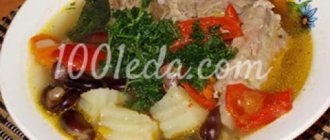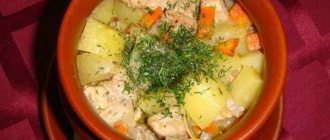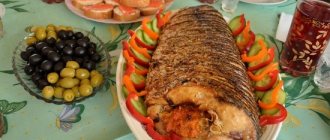This article was produced by our experienced team of editors and researchers, who reviewed it for accuracy and comprehensiveness.
Number of sources used in this article: 7. You will find a list of them at the bottom of the page.
wikiHow's content management team carefully monitors the work of its editors to ensure that every article meets our high quality standards.
Legumes are an excellent addition to a balanced diet. They are rich in antioxidants, vitamins, minerals and fiber. It used to be that they were all carbohydrates, but legumes are low in fat and full of beneficial nutrients. In addition, they are easy to prepare and go well with many dishes, both as a side dish and as a main dish. Dried legumes are often chosen because canned legumes can lack flavor and become soggy easily. Learning how to cook dry beans is a little more challenging than opening a can of canned food, but you'll be rewarded with delicious food.
- Prep Time (Quick Soak): 60-80 minutes (Active Cook: 15 minutes)
- Cooking time: 30–120 minutes
- Total time: 90–200 minutes
My favorite beans March 3, 2012 17:53 Author: zaryanka
I have long wanted to write about the wonderful Russian black beans. Many people have grown or are growing them, but they are clearly not part of our culture. I began to find out why. It turns out that the problem is not growing, but the problem is cooking. Beans have a very hard skin - this, as I understand it, is their main drawback.
black bean recipes
But let's approach the issue differently. Nowadays, when humanity eats mainly very delicate refined food and is accustomed to it, coarse fiber will not harm our digestive organs at all. Yes, vegetables and fruits, but this is in the summer, and winter preparations, as a rule, are thermally processed. As a result, there are not many complete “coarse” products left for us for the winter. I deliberately don’t consider anything from the store. In addition, beans are an immediate “food”, like potatoes or grains. The advantages of beans as a food product include the fact that they can be combined with almost all vegetables, sauces, and meats (perhaps it will just be a little heavy), but I haven’t tried the sweet ones.
My culinary experience in cooking beans was successful, even city residents, many of whom (especially young people) did not know what Russian black beans were, eat them with great pleasure, you can’t drag them away by the ears. The biggest indicator is children. When it comes to unfamiliar food, children are very suspicious and retrograde. But even they managed to turn them around in favor of beans. So, let's move on to cooking the beans. Soak them in the evening (from 5-6 o'clock) in hot water (you can also use cold water). In the morning, when the stove is lit (and in the summer, when you are ready to cook), drain the old water, add fresh water (preferably hot - it will boil faster) so that it covers all the beans, and set to cook. When it boils, add salt to taste and transfer to low heat. And let them cook slowly (40 minutes - 1 hour) until the first cracked specimens appear. Then drain the water and the beans are ready (however, in this stage of readiness they are still a little hard). Here are a few options: 1) Beans stewed with vegetables. Fry the onions and carrots until half cooked (the more vegetables, the better) and add them to the boiled beans, salt to taste. Mix everything, you can add tomato sauce (you can add whatever your heart desires) and simmer under the lid (if you like it drier, without a lid) until the onions and carrots are ready or until the whole mass begins to fry in the frying pan. This dish can be eaten either hot or cold – it’s wonderfully delicious! 2) Beans fried in oil (we call them “chestnuts”). Pour vegetable oil into a frying pan and put the boiled beans in it, sprinkle everything with coarse salt (to taste) and put it on high heat, stirring all the time. The beans are baked, cracked, their crust is fried and begins to crunch - you get a sort of “chips”. which are good both hot and cold. Children like this cooking method the most. 3) Cutlets and bean dumplings. From boiled beans we make minced meat according to all the rules for preparing minced meat, only instead of meat we will have beans. And you can fry cutlets, you can make dumplings. We did both, and everything was very tasty. This third option is especially useful for those who observe fasts. Usually in this case soybeans are used, but if you consider that soybeans are 95% genetically modified, then the conclusion is clear.
Bean soup
How can you cook canned beans? Recipes for preparing dishes from them are quite simple. Therefore, use our description and cook a delicious dish for the whole family in just half an hour. We are sure that you will enjoy the rich taste of the soup and its simple composition. Recipe:
- Open a 400 gram jar of red beans, place them on a plate and mash with a fork.
- Peel one onion and five cloves of garlic. Chop them with a knife.
- Place a two-liter saucepan on the fire, pour a little vegetable oil on the bottom and add the prepared onions and garlic. Add half a teaspoon of oregano to them and fry the food for a few minutes.
- Open a can of tomatoes in their own juice (500 grams) and put them in a saucepan.
- Add one and a half or two liters of chicken broth and half a teaspoon of black peppercorns there.
- Stir the ingredients and wait until the soup boils. After this, reduce the heating temperature and cook the soup for another 20 minutes.
- After this, put the prepared beans and a third of a glass of pasta into it (it is better to take it in the form of shells). Add salt to taste.
When the dish is ready, let it sit under the closed lid for a while, and then serve, garnished with parsley leaves.
A little about beans
Doctors and nutritionists have long been talking about the benefits that this product brings to the body. Peas and lentils, beans and soybeans, chickpeas and peanuts (yes, they're not nuts at all!) and some other legumes are known for their fiber content. In addition, this is the best source of vegetarian protein that is available: it is cheap and (which is important, for example, for ideological vegetarians) you do not need to kill any animals to obtain protein food.
The nutrients found in legumes lower cholesterol levels, normalize blood pressure, and prevent the risks of developing heart disease and such an insidious disease as diabetes. Thanks to the fiber of the product, you feel full for a long time after eating. In addition, this is the best food option for those losing weight. In this article we will look at only a few recipes for cooking beans, although in fact there are a great many of them. In addition, this ingredient allows you to show culinary imagination and experiment - in general, a godsend for beginning “home cooks.”
Side dish of beans and beans
This time we invite you to try a delicious dish that goes well with meat and smoked meats. It can also help you out during Lent or is suitable for a vegetarian menu. Bean recipes are usually very simple, and our dish is a great example of this. What should be done:
- Soak half a cup of dry beans and half a cup of dry beans in separate bowls for several hours.
- After this, boil the products until tender, also separately from each other.
- Peel two large carrots and cut them into cubes.
- Remove the peel from one large onion and cut into half rings.
- Cut two large tomatoes into cubes and finely chop four cloves of garlic.
- Heat a frying pan with a small amount of vegetable oil, fry the carrots with the addition of basil and oregano. After that, remove it with a slotted spoon and transfer it to a dish with beans and beans.
- In the same frying pan, fry the onion and garlic, also remove them with a slotted spoon and transfer to other products.
- Lastly, fry the tomatoes. Don't forget to lightly salt them and season them with ground black pepper and oregano.
Mix the ingredients, sprinkle with chopped herbs and serve the dish.
Important tip
Almost all legumes (excluding legumes, fresh versions of the product) require pre-soaking. It is best to do this at night (if, for example, you are going to prepare a dish in the morning), for 8-12 hours. Some legumes, such as chickpeas, require soaking for 4-6 hours. And if the product is “correct,” then during this time internal processes that promote germination are activated in it. But it doesn’t matter if you have small sprouts: sprouted chickpeas or regular peas in this form are even healthier, and can be safely used in bean recipes. The procedure itself looks quite simple: pour the beans into a suitable container and fill with cold water so that it covers them. After the specified time, drain the water and wash the peas.
Veal stewed with beans
This dish can be described in two words: “nothing complicated,” since among the step-by-step recipes for cooking beans, this one is one of the easiest. Here we will need fava beans (they are also fava beans, garden beans or Russian beans - they are so wide and flat in appearance) - a glass. But if you don’t have them on hand, you can replace them with round beans, beans, and even lentils. However, you should remember that different legumes have different cooking times, so be sure to take this into account. We also use: veal - 1 kilogram, a couple of onions, a head of garlic, spices and a mixture of peppers, salt, a little olive or sunflower oil. And for taste – half a glass of dry sherry (or just table white wine).
Salad with beans and cheese
Here is a recipe for a delicious salad, the main ingredient of which is beans. Recipes for preparing holiday dishes quite often include this component, since it is quite filling and very tasty. How to make bean salad:
- Cut one hundred grams of hard cheese into small cubes or grate on a coarse grater.
- Wash two multi-colored bell peppers, remove the stem and seeds, and then cut into small cubes.
- Open the can of canned beans and drain them in a colander to remove excess liquid.
- Combine all the products in a salad bowl, add a few cloves of garlic, passed through a press.
The light appetizer salad is ready and you can serve it to your guests along with drinks.
Let's cook simply!
- Take a large cast iron cauldron (or a frying pan with high edges) and heat a couple of large spoons of vegetable oil there. Place the veal meat cut into pieces there and fry it on different sides until brownish. Transfer the meat to a separate container.
- Pour the remaining oil into the same frying pan, add the onion chopped into half rings and fry, stirring, until semi-soft. Then add the fried meat to the onion and mix well.
- Add bay leaves (2-3 leaves), crushed garlic, spices and sherry (or dry white). Salt and pepper. Over high heat, bring the whole mixture in the frying pan to a boil, cover with a lid and simmer over low heat for half an hour.
- Then place the prepared soaked beans in a container with the meat. Simmer for another half hour (until the beans are ready).
- Finely chop fresh herbs. Before serving (in portions), sprinkle the veal and beans with chopped herbs: cilantro, parsley, dill, onion.
Cooking instructions
- Boil the pasta in salted water in a saucepan until tender (cooking time is usually indicated on the package).
- Boil the beans, soaked in advance, until tender. By the way, for this dish you can also take beans canned in their own juice (only then you need to rinse them in running water, and there is no need to cook them).
- During the last few minutes of the pasta cooking, add the beans to the pot with the pasta. Place the mixture in a colander, allowing excess water to drain.
- Transfer from the colander back to the pan where everything was cooked.
- Add chopped parsley, green onions with butter, grated Parmesan and lemon zest, salt and pepper. Mix all this thoroughly and let it stand for a while under the lid.
- Serve the dish hot, in portioned plates - piping hot.
Black beans
The whole world has long appreciated black beans. Recipes for preparing this product are quoted in the East. By the way, the protein of this plant is very close to its animal varieties. It contains a lot of vitamins (A, E). Black beans are especially popular among the Japanese. Here they are used to prepare many different products that have a slight taste of roasted peanuts, grind them into flour, and make the national dish - tofu. Attention: dried seeds require long-term soaking before cooking (up to 24 hours).
The easiest recipe for cooking black beans is with rice. This is a common but very tasty Japanese dish. To prepare it, you need to take boiled black beans and rice in equal proportions (for example, a glass of rice - the unpolished version works very well - and a glass of legumes), then salt, pepper, add butter, seasonings - that's all! Cook the beans for about an hour, and the rice for half an hour (we prepare the ingredients in separate containers and then mix).
Beans. Vegetable patriarchs
Ecology of nutrition. A real delicacy is beans in a state of milky ripeness: tender, green grains. They can be eaten raw. You can keep it in boiling water for 3 – 4 minutes and add it to the salad in this form.
In Egypt, only members of the royal family were allowed to eat them, the ancient Greek mathematician and philosopher Pythagoras died out of respect for beans, Prince Vladimir considered beans a strategic crop, and Natalya Ivankevich shares her favorite recipe for cooking beans in Provencal style.
Remembering the cheerful Bean King from the painting of the same name by Jordaens or hearing the expression “stayed on the beans,” it inevitably seems that beans belong to a distant, foggy past that has nothing to do with the modern world. There is some truth in this - but only in the fact that the beans, which gave the name to the whole family (and there are only about a dozen edible representatives of the legume family) are truly the patriarchs among vegetables. Historians believe that man began to grow beans 10 thousand years ago in Asia Minor.
The ancient Egyptians were afraid of beans; only members of the royal family were allowed to eat them. Black “mourning” spot on a flower; a fruit shaped like an embryo - what else is needed to connect life and death, dying and rebirth? It was believed that the bean field was a place where the souls of the dead awaited their reincarnation, and mere mortals did not dare enter this field.
Bean King. Jacob Jordaens. 1638 160 x 213 cm The Bean King. Jordaens, Jacob. Hermitage, St. Petersburg
Pythagoras, after two decades of studying with the Egyptian priests, borrowed from them, along with secret mystical knowledge, their attitude towards beans. He categorically forbade his disciples to enter the bean field, let alone eat them. Legend has it that Pythagoras died, pursued by his enemies, at the edge of a bean field that he did not dare cross.
In Ancient Rome, beans were treated more simply. The Romans were not keen on the transmigration of souls; they did not pay attention to the black spots, but they noted the shape of the embryo in the fruits and associated the beans with the cult of fertility. Without avoiding the echoes of ancient beliefs, they were perceived as a gift from the dead to the living. This gift had to be appreciated, namely boiled, stewed, fried, in pods and without them. The legendary Apicius, the same one who squandered his huge inheritance on gastronomic delights and committed suicide when he realized that the remaining money was only enough for him to live like an ordinary wealthy person, provides numerous recipes for bean dishes in his cookbook. And Apicius knew a lot about food!
A real delicacy is beans in a state of milky ripeness: tender, green grains. They can be eaten raw.
In the Middle Ages, the connection of beans with fertility smoothly flowed into the symbolism of prosperity and prosperity, and beans took an active part in both wedding ceremonies and voting procedures (white beans / black beans).
In Russia, beans were valued in the same way as throughout Europe. For example, among other things, the chronicles mention the construction of storage facilities for beans by Prince Vladimir. In those days, everywhere, and for quite a long time, dry beans were considered as the main element of the country's strategic reserve - in case of crop failure, famine, wars and natural disasters. After all, mature beans have two very important properties: they are stored for a long time and contain a large amount of proteins, which means they are very nutritious.
Blanched milk beans.
How to cook beans
But the 16th century came, Columbus and his followers brought potatoes and beans from the New World, which gradually but inexorably displaced turnips and beans from the fields and tables of Europeans - new crops were prepared faster and easier, and provided more variety.
However, beans have never completely disappeared from our gardens, and recently this interesting and well-deserved vegetable has been experiencing a real renaissance.
A real delicacy is beans in a state of milky ripeness: tender, green grains.
They can be eaten raw.
You can keep it in boiling water for 3 – 4 minutes and add it to the salad in this form.
You can cook soup from them or add them to a stew - the beans will reveal their special delicate taste everywhere.
In any dish, young beans will reveal their special delicate taste.
In 100 gr. young fresh beans contain only 35 kcal - despite the fact that the beans are rich in fiber, vitamin C, proteins and carbohydrates, and have an antispasmodic and sedative effect.
But dry beans contain almost 10 (!) times more calories - 345 kcal per 100 g. And dishes made from dry beans are much more difficult to digest.
By the way, if you want a dish of fresh beans not to irritate even the most delicate stomach, remove the film covering them from the beans. This film comes off easily from blanched beans, almost by itself, but if you want to peel raw beans, you will have to spend a little more time. But the result is worth it!
To prevent a dish of fresh beans from irritating your stomach, remove the film covering them from the beans.
And finally, my favorite recipe.
Provençal beans
1. Blanch young bean grains in boiling water for 5 - 7 minutes.
2. Lightly fry finely chopped onion, add sweet pepper (diced), tomatoes (without skin and seeds), finely chopped garlic.
3. Simmer everything over low heat until soft, about 10 minutes.
4. Add beans, salt, pepper, a pinch of Provençal herbs.
5. Simmer everything together for another 15 - 20 minutes. Published
Beans in Provençal style.
Natalya Ivankevich - curator of the LavkaLavka vegetable program
PS And remember, just by changing your consumption, we are changing the world together! © econet
Join us on Facebook, VKontakte, Odnoklassniki
Fresh beans. Cooking recipes
There are also quite a lot of them in cookbooks of various peoples and countries. We now bring to your attention the simplest recipe for making green beans.
- We wash the young green beans thoroughly, cut off the pods on both sides and place them in a saucepan with boiling water (slightly salt them first).
- Cook over low heat, covered, for a quarter of an hour (until the product is soft).
- Drain the water, melt a piece of butter and mix with the pods.
- Sprinkle with freshly ground black pepper and sprinkle with the juice of half a lemon. You can also serve it on the table!











